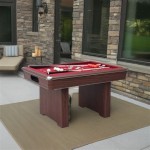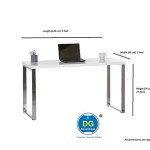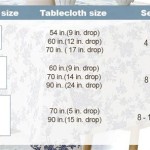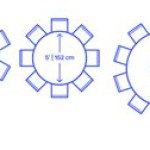72 Round Table Seats: How Many?
The question "72 Round Table Seats: How Many?" appears deceptively simple. The immediate and obvious answer is 72. However, exploring the implications and potential contextual interpretations of this query reveals a range of scenarios beyond a direct numerical response. Understanding what is being asked requires considering the purpose and characteristics of a round table, the potential physical arrangements of seats around it, and the broader symbolic meaning it might represent.
A round table is fundamentally designed to promote equality and open communication among participants. The absence of a head or prominent position eliminates hierarchy, fostering a sense of shared responsibility and collaborative decision-making. This inherent structure directly influences how seating arrangements are perceived and utilized. While 72 chairs can numerically accommodate 72 individuals, the practical and symbolic effectiveness of such a large gathering around a single round table needs careful examination.
The concept of a round table, deeply rooted in Arthurian legend, carries significant symbolic weight. King Arthur's Round Table was a symbol of unity, fellowship, and democratic ideals. Knights gathered as equals to discuss matters of importance, embodying the principles of chivalry and justice. Therefore, when considering the question of "72 Round Table Seats: How Many?" the historical and symbolic implications associated with the round table tradition should not be overlooked.
Practical Considerations for Seating 72 People
While theoretically a round table could accommodate 72 chairs, the feasibility and effectiveness of such an arrangement are questionable from a practical standpoint. Consider the physical dimensions required for each individual to have adequate personal space, the difficulty in projecting voices across such a large diameter, and the logistical challenges of serving food and beverages. A table designed for 72 seats would necessitate an enormous diameter, potentially hindering effective visual contact and communication among participants. Conversation would become strained, and the very purpose of fostering equality and collaboration would be undermined.
Furthermore, accessing the center of the table for presentations, placing shared materials, or even simply reaching for refreshments would be problematic for those seated further away. The sheer size of the table would also impose limitations on the venue in which it could be housed. Most banquet halls or conference rooms would simply not have the spatial capacity to accommodate such a structure. Specialized venues or outdoor settings would be required, adding to the overall logistical complexity and expense.
An alternative approach might involve using multiple smaller round tables, each seating a more manageable number of participants. This would allow for more intimate group discussions and facilitate easier interaction. The smaller tables could then be arranged in a circular or semi-circular configuration to maintain a sense of unity and connection within the larger group. This hybrid approach balances the symbolic significance of the round table with the practical considerations of accommodating a large number of individuals. The choice of table size for these smaller groups would depend on the desired level of interaction and the specific tasks assigned to each group.
Alternatives to a Single Large Round Table
Beyond the physical limitations of a single large round table, alternative seating arrangements can offer more effective ways to facilitate communication and collaboration among 72 individuals. A horseshoe-shaped configuration, for example, allows everyone to face a central focal point, such as a speaker or presenter. This setup is particularly well-suited for presentations, lectures, or interactive workshops where visual aids and direct communication with the presenter are essential. However, the horseshoe shape may not foster the same sense of equality and shared responsibility as a round table, as the focus is primarily directed towards the person at the open end of the horseshoe.
Rectangular tables arranged in a U-shape or a hollow square can also be effective for larger gatherings. These configurations provide a more structured environment for formal meetings or conferences, while still allowing for some degree of interaction among participants. The U-shape is particularly useful for encouraging discussion and debate, as individuals can easily see and hear each other. However, these arrangements may not be as conducive to informal networking and relationship building as round tables, which inherently encourage a more relaxed and egalitarian atmosphere.
Theater-style seating, with rows of chairs facing a stage or presentation area, is suitable for large audiences who primarily need to passively receive information. This arrangement is not ideal for collaborative activities or discussions, as it limits interaction among participants. However, if the primary goal is to deliver a lecture or presentation to a large audience, theater-style seating can be the most efficient way to accommodate a large number of people in a limited space.
Symbolic Implications and Interpretations
The phrase "72 Round Table Seats: How Many?" can also evoke deeper symbolic interpretations, particularly in contexts related to organizational structure, leadership, and decision-making processes. The number 72, while seemingly arbitrary, may hold specific significance within a particular organization or community. It could represent a target number of members, a specific budget allocation, or a milestone achievement.
In a broader conceptual sense, the question might prompt reflection on the principles of inclusivity, shared governance, and the distribution of power. A round table, as a symbol of equality and collaboration, suggests a commitment to these values. However, the sheer number of 72 participants raises questions about the practicality of achieving genuine consensus and shared decision-making. Larger groups can often be more challenging to manage and may require more structured processes to ensure that all voices are heard and considered.
The question could also be interpreted as a challenge to traditional hierarchical structures. The desire to accommodate 72 individuals at a round table might indicate a desire to flatten organizational hierarchies and empower more individuals to participate in decision-making processes. However, implementing such a change requires careful planning and consideration of the potential implications for efficiency and accountability. A balance must be struck between fostering inclusivity and ensuring that decisions are made in a timely and effective manner.
Ultimately, the true meaning of "72 Round Table Seats: How Many?" depends heavily on the specific context in which it is asked. A direct answer, "72," is a straightforward numerical response. However, the underlying intent behind the question may be far more complex, encompassing practical considerations about seating arrangements, logistical challenges, and the symbolic implications of a large-scale round table gathering. Understanding these nuances is crucial for providing a comprehensive and meaningful answer.

Professional Table Seating Guide The Chiavari Chair Company

72 Round Table Ocean Atlantic Event Als

How Many Chiavari Chairs Can You Put Around A 72 Inch Round Table National Event Supply

72 Round Plywood Table American Party Als

72 Round Seats 10 12ppl Tesoro Event Als

72 In Round Table Mtb Event Als

72 Round Table For Orange County Ca On Call Event Als

Reception Seating Big Tent Events

72 Round Table Raymond Brothers Limited

Lifetime 72 Inch Round Table Commercial








